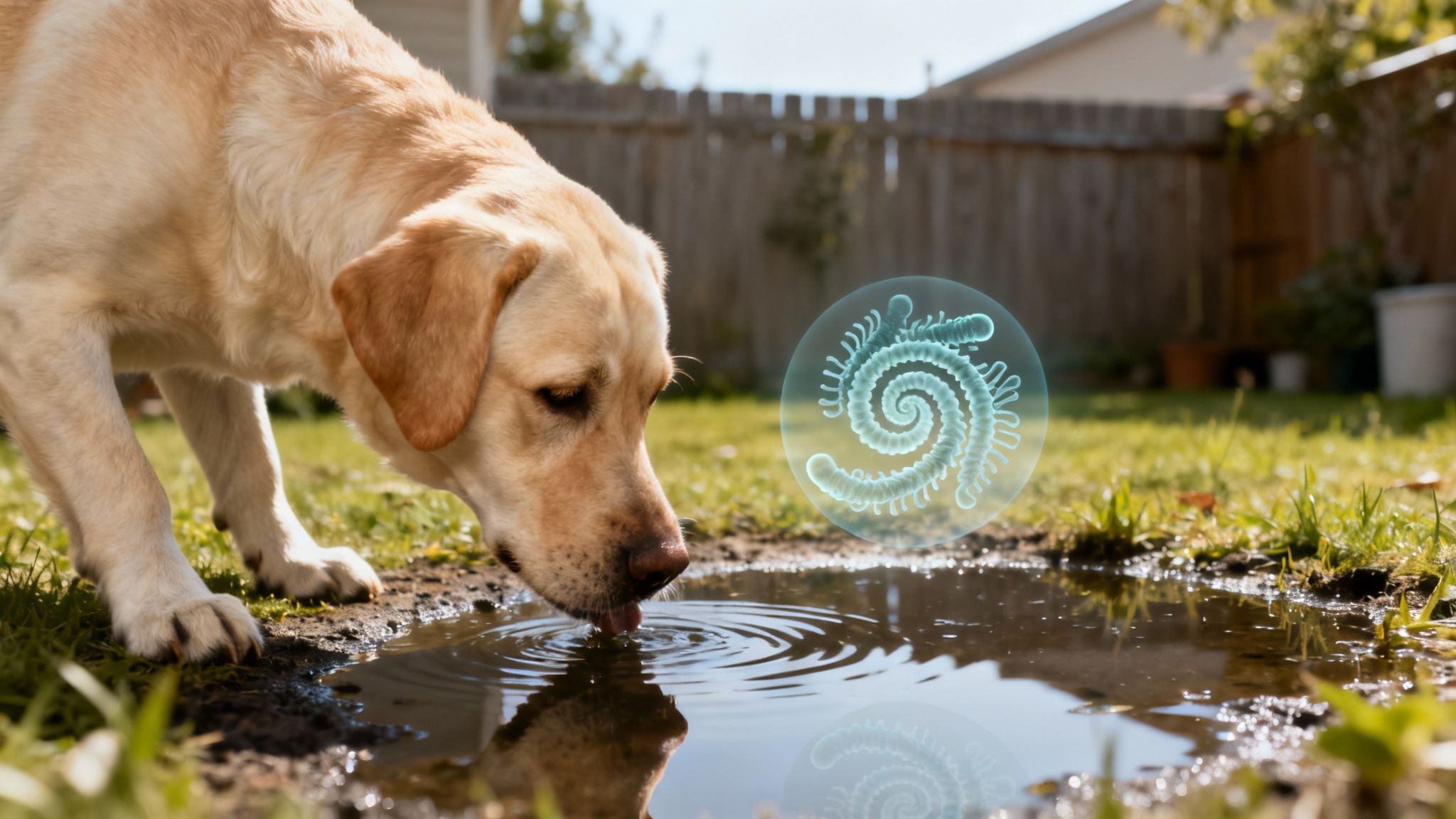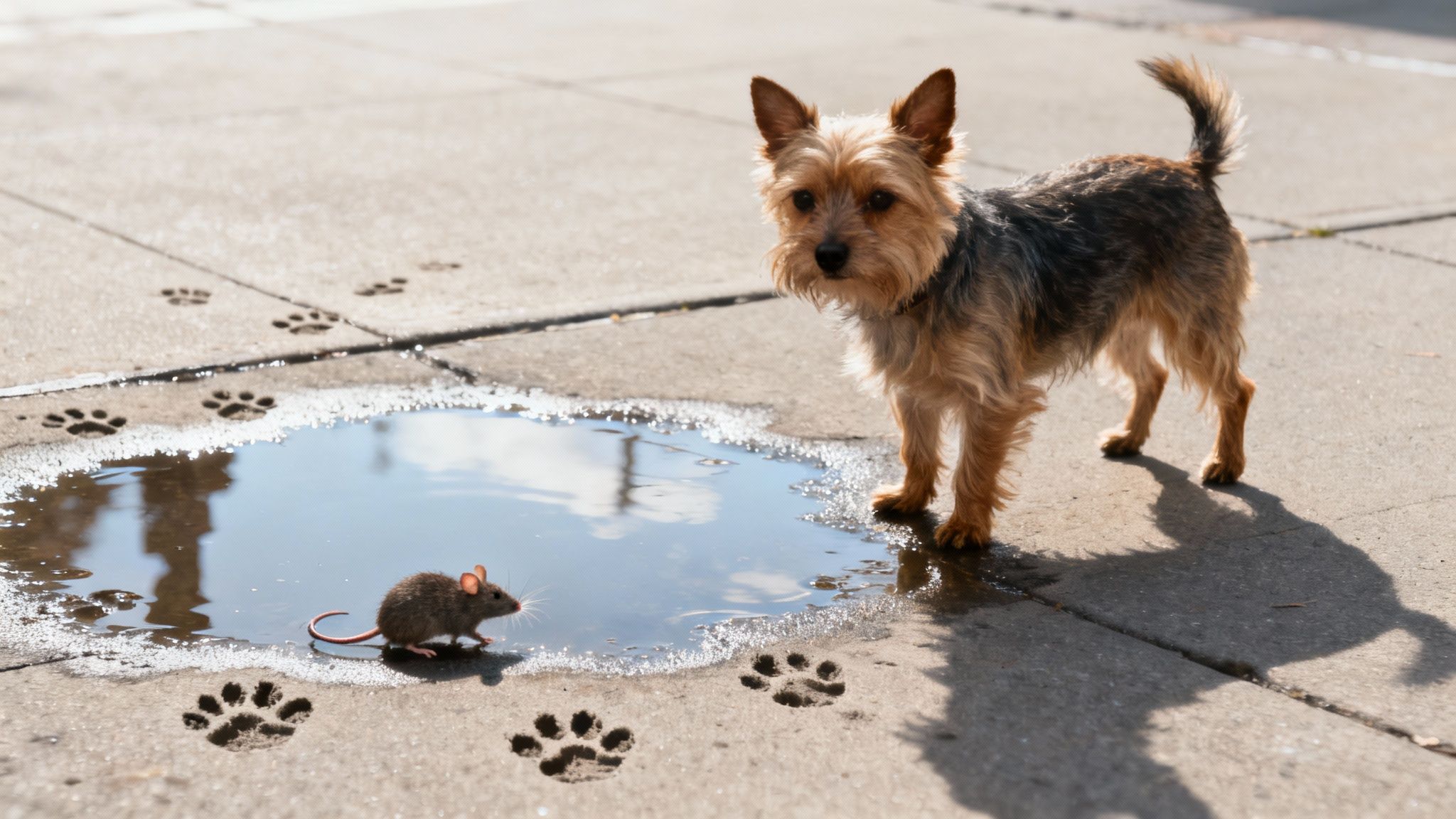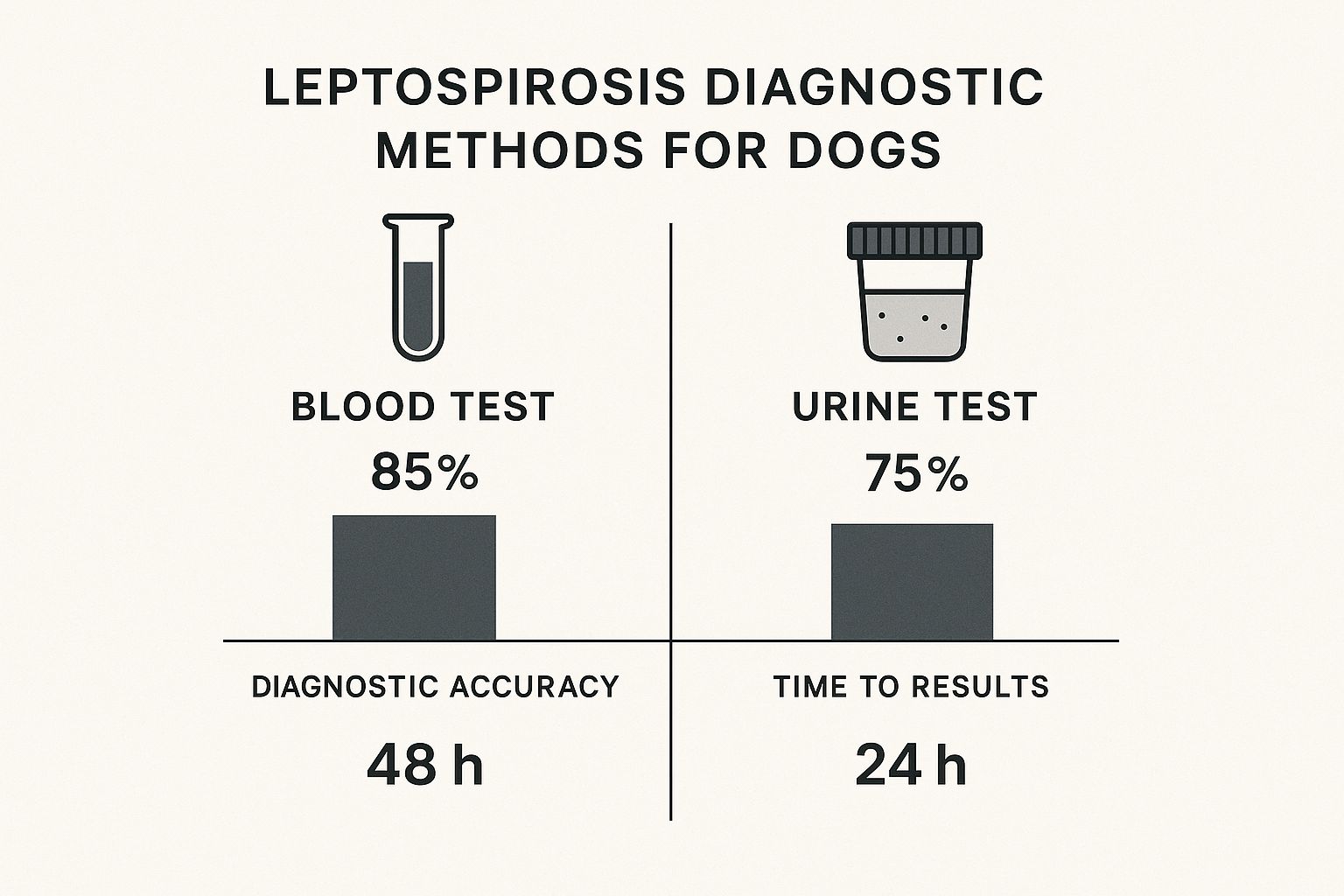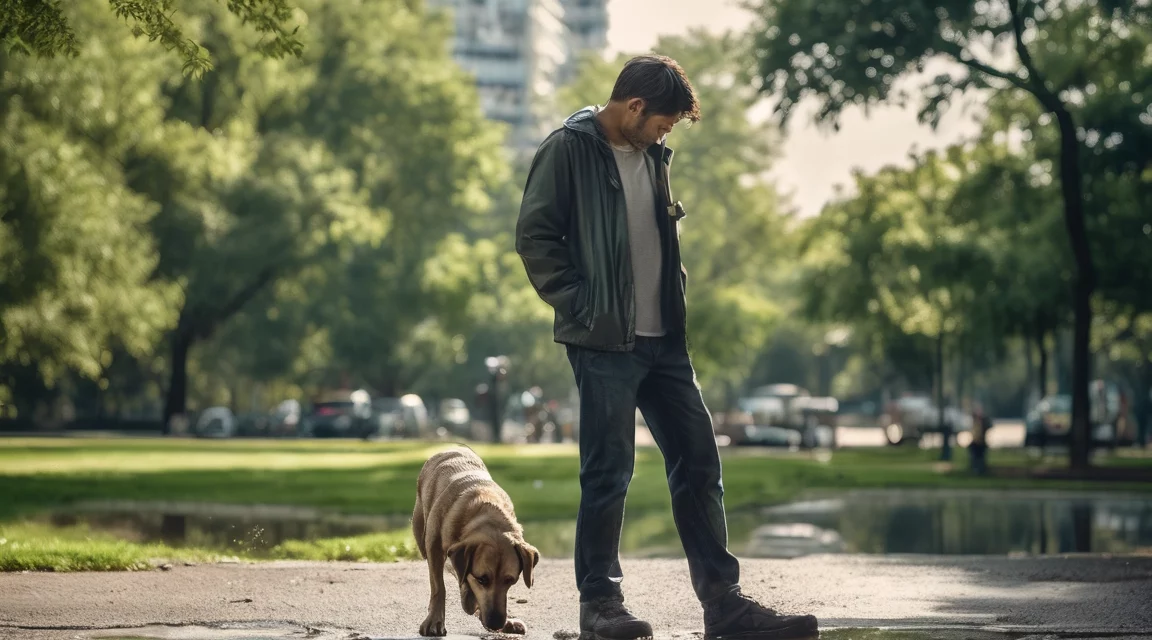Leptospirosis is a nasty bacterial disease that can be a real worry for us dog owners. It’s caused by spiral-shaped Leptospira bacteria, which just love damp environments. If it’s left untreated, it can lead to serious kidney and liver damage, and that’s something we all want to avoid.
Knowing how this illness spreads is the first, most important step you can take to protect your best mate.
Understanding Leptospirosis in Your Dog

We know your dog’s health means the world to you. That’s why we need to have a heartfelt chat about leptospirosis. It’s a dangerous but preventable illness that can lurk in the most innocent-looking places, from a muddy puddle on a country walk to a damp patch in your own back garden.
Leptospirosis is caused by several strains of the Leptospira bacteria. Think of them as stealthy invaders. They’re incredibly tough and can hang around for weeks, even months, in damp soil or standing water, just waiting for a dog like yours to come along.
When your dog has a sniff, a lick, or a drink from a contaminated source, these corkscrew-shaped bacteria can get into their system. They usually enter through the gums, nose, or even tiny cuts in their skin. Once inside, they multiply and travel through the bloodstream, heading straight for the vital organs.
The Unseen Threat
These bacteria primarily set up shop in the kidneys and liver. They cause inflammation and damage that can seriously disrupt how these organs work. In the worst-case scenarios, this can lead to acute kidney failure or severe liver disease, which is often life-threatening and utterly heartbreaking for any owner.
The main culprits for spreading Leptospira are wildlife, especially rodents like rats. Infected animals pass the bacteria in their urine, contaminating the ground and water around them. This creates invisible hotspots of risk in all the places your dog loves to explore.
The real problem with leptospirosis in dogs is that exposure can happen during any normal outdoor activity. A simple drink from a puddle or a sniff in a damp patch of grass is all it takes for the bacteria to find a way in.
To help you get a quick handle on the key facts, here’s a simple summary of what you need to know about leptospirosis.
Leptospirosis in Dogs at a Glance
| Key Aspect | Simple Explanation |
|---|---|
| What It Is | A serious bacterial infection that attacks a dog’s kidneys and liver. |
| How It Spreads | Through contact with urine from infected animals, often found in soil and water. |
| Main Carriers | Wildlife, especially rodents like rats, but also foxes and badgers. |
| High-Risk Areas | Puddles, ponds, slow-moving streams, and damp, boggy ground. |
| Risk to Humans | Yes, it’s zoonotic, meaning it can pass from animals to people. |
This table covers the basics, but understanding the ‘why’ behind the risk is just as important for keeping your dog safe.
Why Every Owner Should Be Aware
Leptospirosis is caused by what are known as pathogenic bacteria; learning more about what pathogenic bacteria are can give you a much better understanding of the risks your dog might face on a daily basis.
Here are a few key points to keep in your heart:
- Environmental Survival: Leptospira thrives in wet, warm conditions, which is why the autumn and spring months are particularly high-risk seasons here in the UK.
- Subtle Transmission: Your dog doesn’t need to meet an infected animal face-to-face. The environment itself becomes the source of danger.
- Zoonotic Potential: This isn’t just about your dog’s health. It’s a disease that can also affect you and your family, making awareness crucial for everyone’s wellbeing.
Our goal isn’t to scare you, but to arm you with knowledge. By understanding the basics of leptospirosis, you’re taking the most important step towards becoming your dog’s best protector.
Recognising the Warning Signs in Your Dog

As dog owners, we become fluent in our dog’s personal language. You know the exact ear-twitch that signals an impending walk or the specific sigh that says they’re blissfully content. This intuition is your superpower when it comes to spotting an illness, especially a sneaky one like leptospirosis.
One of the most frustrating things about this disease is how its early symptoms mimic so many other, less serious issues. It’s all too easy to write off a bit of tiredness as the aftermath of a long walk, but sometimes it’s the first sign that something is deeply wrong.
Let’s break down what you need to look for, splitting the signs into two categories: the early, subtle hints and the more urgent, critical indicators. Spotting these signs quickly is absolutely vital for getting your dog the help they need.
Early and Subtle Symptoms to Watch For
These are the first clues that your dog just isn’t feeling themselves. They can be vague, so it’s important to trust your gut if you feel something is off.
- Sudden Lethargy or Depression: Has your normally bouncy companion suddenly lost interest in playing or going for a walk? This dip in energy is often one of the very first signs.
- Shivering or Muscle Tenderness: Your dog might seem stiff, sore, or reluctant to be petted. This is often down to muscle pain and fever as the infection takes hold.
- Loss of Appetite: If your food-obsessed friend suddenly turns their nose up at their favourite dinner, it’s a big red flag that something isn’t right.
- Vomiting and Diarrhoea: While lots of things can cause a stomach upset, if it persists, it’s a common symptom of lepto as the bacteria begin to affect their system.
A fever is also a very common early indicator. If you’re worried, knowing how to check your dog’s temperature can give your vet some crucial information.
It’s so important to remember that these signs can look very different from dog to dog. The illness might pop up as just one or two mild symptoms, or it could progress frighteningly fast. That’s why paying close attention is so crucial.
Urgent and Severe Warning Signs
As the infection worsens and starts to hit the kidneys and liver hard, the symptoms become much more alarming. If you spot any of the following, you must contact your vet immediately. This is an emergency.
- Increased Thirst and Urination: This is a classic sign of kidney trouble. Is your dog draining the water bowl much faster than usual or constantly asking to go outside?
- Jaundice: Take a close look at your dog’s gums, the whites of their eyes, and the skin inside their ears. A yellow tinge, known as jaundice, points to severe liver damage.
- Unusual Bleeding: This could be anything from nosebleeds and blood in their urine or stool, to tiny red spots (called petechiae) on their gums.
- Swelling: You might notice swelling in their legs or tummy due to fluid retention, which is a sign of organ failure.
The list of possible symptoms is long and can include everything from fever and gut problems to coughing and severe kidney injury. Getting a professional diagnosis as quickly as possible gives your dog the best chance of pulling through.
Where the Risk of Leptospirosis Hides in the UK

It’s easy to think of leptospirosis as a disease of the countryside. A risk for those hardy farm dogs or adventurous pups who spend their days splashing through streams and fields. While those environments are definitely hotspots, the truth is that the bacteria responsible are much closer to home for all of us here in the UK.
The risk of leptospirosis in dogs isn’t just a rural problem anymore. It’s lurking in suburban gardens, local parks, and even on city pavements after a good rain shower.
Understanding where these dangers hide is the first step in keeping your best mate safe on your daily walks, no matter where you live. Let’s have a look at the specific places your dog might encounter Leptospira bacteria.
Rural Hotspots
For those of us who love escaping to the country, it’s vital to be aware of the classic risk zones. The bacteria absolutely thrive in damp, slow-moving water and moist soil, making these areas prime territory.
- Farmland and Livestock Areas: Fields where cattle, sheep, or pigs graze can be contaminated. Their urine can carry the bacteria, which then seeps into the soil and any nearby water.
- Slow-Moving Water: Think of canals, ponds, and boggy marshes. These spots are perfect breeding grounds because the bacteria aren’t quickly washed away.
- Streams and Rivers: While fast-flowing water is less of a concern, the muddy banks and calmer eddies along the sides are ideal places for Leptospira to hang about.
It’s so important to discourage your dog from drinking from or even swimming in these water bodies. A simple, joyful splash could unfortunately lead to a very serious infection.
Urban and Suburban Surprises
This is where the risk becomes a genuine surprise for many of us. You don’t need to be out on a sprawling farm for your dog to be exposed. Everyday urban and suburban spots are now recognised as significant sources of leptospirosis.
The main reason? Wildlife. Animals like rats, foxes, and even squirrels are excellent carriers. As they move through our towns and cities, they leave a trail of contamination in their urine, turning seemingly harmless spots into potential dangers.
The biggest shift we’re seeing is the move from a “country disease” to an “everywhere disease.” A puddle on a city street or a damp patch of soil in a suburban garden can be just as risky as a rural pond if a carrier animal has recently passed through.
This shift in understanding is critical. Historically, leptospirosis was linked with working dogs in the countryside, but recent findings show a startling trend. Toy breeds and dogs living in built-up areas now face a higher risk.
Geographically, while cases pop up across the UK, the highest presence has been recorded in the South East of England, with other hotspots in the West Midlands and South West, including Wales. You can read more about these regional findings to get a clearer picture of the risks in your area.
How Everyday Activities Create Risk
Infection often happens during the most ordinary parts of your dog’s day. It’s not about dramatic encounters; it’s about the small, seemingly insignificant moments of exploration that every dog loves.
Here’s how a dog can most commonly pick it up:
- Drinking from Puddles: A quick slurp from a puddle on the pavement or in the park is a direct route for the bacteria to get into their system.
- Sniffing Contaminated Soil: Dogs explore the world with their noses. A deep sniff in a damp patch of grass where an infected animal has urinated can be enough.
- Contact with Cuts: Even a tiny cut or graze on their paw can be an entry point if they walk through contaminated water or mud.
We can’t wrap our dogs in cotton wool, and we wouldn’t want to. But by being mindful of these small moments, we can gently guide them away from the biggest risks and keep their adventures as safe as they are fun.
How Vets Diagnose and Treat an Infection
Hearing your vet mention a word like leptospirosis can make your heart sink. It’s a scary moment, and the uncertainty can feel overwhelming. But knowing what happens next can help you feel more in control and better prepared to help your dog through it.
When you arrive at the vet with your poorly dog showing potential signs of lepto, their first priority is to act fast. Think of it like a bit of detective work; they need to gather specific clues to build a clear picture of what’s happening inside your dog’s body. A quick, accurate diagnosis is absolutely critical, as getting treatment started early gives your dog a much better chance of a full recovery.
The Diagnostic Journey
Your vet will start with a thorough physical exam and ask you plenty of questions about your dog’s recent activities and symptoms. After that, they’ll almost certainly recommend a combination of blood and urine tests. These are the cornerstones of figuring out if leptospirosis in dogs is the culprit.
Here’s what they’re usually looking for:
- Blood Tests: A complete blood count (CBC) and a chemistry panel are essential. These check for signs of infection (like a change in white blood cell count) and, crucially, assess how well the kidneys and liver are coping. High levels of certain enzymes can be a red flag for serious organ damage.
- Urine Tests: A urinalysis can reveal if the kidneys are struggling to concentrate urine properly. Vets might also use a special Polymerase Chain Reaction (PCR) test on the urine, which looks for the DNA of the Leptospira bacteria itself.
- Antibody Tests: Another key blood test, known as the Microscopic Agglutination Test (MAT), checks for antibodies your dog’s immune system creates to fight the bacteria. A rising level of these antibodies over a couple of weeks is a strong indicator of an active infection.
Diagnosing lepto isn’t always straightforward, though. A 2022 study by the Royal Veterinary College estimated that the annual risk in the UK is around 0.8 cases per 100,000 dogs, but noted that challenges in diagnosis can affect these figures. You can learn more about the study’s findings on canine leptospirosis for a deeper insight.
The Two-Pronged Treatment Plan
Once the vet has a confirmed or strongly suspected diagnosis, they’ll launch a two-pronged attack. The goal is to fight the infection while supporting your dog’s body. Treatment is often aggressive and usually means your dog will need to be hospitalised, at least in the early stages.
The main aims are simple: kill the bacteria and manage the damage it’s already done.
The core of the treatment involves a powerful course of antibiotics to clear the bacterial infection, combined with intensive supportive care—like intravenous fluids—to protect and help heal the vital organs under attack.
This approach gives your dog the best possible chance to bounce back. The exact plan will be tailored to your dog’s specific condition, focusing on what they need most urgently.
Fighting the Bacteria and Supporting the Body
First up is a course of antibiotics. Your vet will likely start with one type of antibiotic to quickly get the infection under control, then switch to another, like doxycycline, to clear out any stubborn bacteria hiding in the kidneys. It’s so important to finish the entire course, even if your dog seems to be feeling much better.
The second, equally vital, part is supportive care. This often includes:
- Intravenous (IV) Fluids: These are a lifeline. They rehydrate your dog, support their blood pressure, and help flush the nasty toxins from their kidneys.
- Medication for Symptoms: This could include anti-nausea drugs to control vomiting or other medicines to protect the stomach lining.
- Nutritional Support: If your dog isn’t eating, they might need a bit of encouragement or a special diet to get the energy they need to heal.
This all-hands-on-deck approach tackles the illness from every angle. It’s an intensive process, but it’s designed to give your beloved companion the robust support they need to fight back and get on the road to recovery.
Vaccination and Everyday Prevention Strategies
When you’re up against something as serious as leptospirosis in dogs, prevention is without a doubt your most powerful tool. It’s all about taking proactive steps to protect your best mate, and the cornerstone of any good strategy is vaccination. It’s a simple, but vital, conversation to have with your vet.
Beyond the jab, prevention is something we weave into our everyday lives. It’s about making small, mindful tweaks to how you and your dog enjoy the great outdoors. Let’s walk through the key things you can do to slash your dog’s risk and give yourself a bit of peace of mind.
Understanding the Leptospirosis Vaccine
In the UK, when you chat with your vet about the lepto vaccine, you’ll probably hear the terms “L2” and “L4.” Think of these as different versions of a security update for your dog’s immune system. The “L” stands for Leptospira, and the number simply tells you how many strains of the bacteria it protects against.
- The L2 Vaccine: This is the older, more traditional vaccine. It covers the two strains that were, for a long time, considered the most common threats here in the UK.
- The L4 Vaccine: This is the more modern option, offering much broader protection. It covers the same two strains as the L2, plus two more that have cropped up more frequently in recent years.
Choosing between L2 and L4 isn’t a case of one being “good” and the other “bad.” It’s about tailoring the protection to your dog’s lifestyle and the known risks in your local area. This is why a proper chat with your vet is so important.
Many vets now recommend the L4 vaccine as standard simply because it gives more complete coverage against the strains we’re actually seeing out and about. For a full rundown of what’s involved, you can learn more about the complete schedule of recommended dog vaccinations and how they all fit together.
To help you see the differences at a glance, here’s a quick comparison of the L2 and L4 vaccines.
Comparing L2 and L4 Leptospirosis Vaccines
| Feature | L2 Vaccine | L4 Vaccine |
|---|---|---|
| Strains Covered | Protects against 2 historically common strains of Leptospira. | Protects against 4 strains, including the original two plus two more recent ones. |
| Level of Protection | Standard, traditional protection. | Broader, more comprehensive protection. |
| Best For | Dogs with lower-risk lifestyles in areas with historically low prevalence. | Most dogs, especially those who swim, explore rural areas, or live where new strains are common. |
| Vet Recommendation | Less commonly used as the primary choice now. | Often recommended as the standard of care by UK vets. |
Ultimately, the L4 vaccine provides a wider safety net, which is why it’s become the go-to for most vets.
Simple Habits for Everyday Prevention
Vaccination is your main line of defence, but it doesn’t work in a bubble. You can bolster that protection with some simple, practical habits that reduce your dog’s chances of ever coming into contact with the bacteria.
It’s all about managing their environment and steering them away from the biggest risks. You don’t need to wrap them in cotton wool, just be a bit more aware when you’re out and about.
Here are a few easy tips to build into your routine:
- Avoid Standing Water: Puddles, ponds, and slow-moving streams are perfect breeding grounds for Leptospira. Do your best to stop your dog from drinking from or swimming in these places. Always carry fresh water for them on walks.
- Manage Your Garden: Keep your garden tidy. Clear away rubbish and overgrown spots that could attract rodents. Make sure your bins are secure and don’t leave pet food outside, as it’s an open invitation for wildlife.
- Be Mindful on Walks: Steer your dog away from really boggy or muddy areas, especially after heavy rain when everything is saturated.
This infographic gives you a quick look at the two main tests your vet might use if they suspect an infection.

As you can see, the urine test gets you faster results, but the blood test is much more accurate for confirming an infection, which is absolutely crucial.
Creating a Safer Home Environment
Prevention starts right at your own front door. Since rodents are major carriers of leptospirosis, making your home and garden less welcoming to them is a massive step in protecting your dog and your family.
Simple things can make a huge difference. Check for gaps in fences or holes near your house’s foundations where rats or mice might sneak in. If you have a compost bin, make sure it’s a sealed unit that won’t attract pests.
By combining a solid vaccination plan with these mindful, everyday habits, you create layers of protection. It’s a team effort between you, your vet, and your own awareness—all working together to keep your dog healthy, happy, and safe on all their adventures.
Keeping Your Whole Family Safe
Learning your dog has an illness like leptospirosis is worrying enough. But hearing it can also affect humans adds a whole new layer of concern, and we completely understand that. The good news is that while leptospirosis is a zoonotic disease—meaning it can pass from animals to people—it’s actually quite rare for this to happen.
Our goal isn’t to cause alarm, but to give you the knowledge to handle the situation calmly. By taking a few simple, common-sense precautions, you can create a safe environment for everyone in your household, both two-legged and four-legged.
Simple Hygiene for Peace of Mind
If your dog has been diagnosed, the most important thing is to manage any contact with their urine, as this is how the bacteria are spread. Think of it as putting a temporary, invisible safety barrier in place while they get better. Your vet will give you specific advice, but these general hygiene practices are key.
Here are some straightforward but vital steps to take:
- Wear Gloves: Always pop on a pair of disposable gloves when cleaning up any wee in the house or handling bedding that might be soiled.
- Wash Hands Thoroughly: Get into the habit of rigorous handwashing with soap and warm water after petting your dog or handling their food bowls, bedding, or toys.
- Disinfect Surfaces: Use a pet-safe antibacterial cleaner to disinfect any areas where your dog has had an accident.
It’s crucial to remember that a dog can continue to shed bacteria in their urine for weeks, even after they start feeling better. Following your vet’s full course of treatment and hygiene advice is the best way to protect your whole family.
Managing Your Home and Garden
Beyond personal hygiene, a few adjustments around your home and garden can make a big difference. This is particularly important if you have young children, who are more likely to be playing on the floor or in the garden. It’s a good idea to designate a specific, easy-to-clean area for your dog to relieve themselves outside, and keep other pets and children away from that spot for the time being.
Since rodents are one of the main carriers, making your property less inviting to them is a smart move for everyone. So, on top of direct prevention for your dog, implementing effective strategies for managing rat infestations around your home can significantly cut down the overall risk.
For more general advice on handling pet-related incidents, our guide to essential dog first aid tips offers valuable insights. By staying calm and being careful, you can confidently manage the situation and make sure everyone stays healthy.
Common Questions About Leptospirosis
We’ve covered a lot of ground, but we bet you still have some questions bubbling away. It’s only natural – being a responsible dog owner means wanting to know every last detail when it comes to their health.
Trying to get your head around an illness like leptospirosis in dogs can feel like a lot to take on, but you’re not in this alone. To help clear things up, we’ve put together some straight-talking answers to the questions we hear most often from fellow dog lovers.
Can My Vaccinated Dog Still Get Leptospirosis?
This is a brilliant question, and the simple answer is yes, but the risk is massively reduced. Think of the vaccine as a top-notch security system, not an impenetrable fortress. A vaccinated dog could still get infected if they come up against a bacterial strain that isn’t covered by their specific jab. For instance, a dog with the L2 vaccine might be exposed to a strain that only the L4 vaccine protects against.
So, why bother with the vaccine? Because it’s still absolutely vital.
Vaccination drastically cuts the chance of your dog becoming seriously ill. If they do happen to get infected, the symptoms are usually much milder and the outcome is far better. It gives their immune system the fighting chance it needs to get on top of the infection quickly.
It’s a bit like the human flu jab – it protects against the most common and dangerous strains doing the rounds, but it can’t offer a 100% guarantee against every single one out there.
Is Leptospirosis Contagious Between Dogs?
Yes, leptospirosis can be passed from one dog to another. The main way this happens is through contact with infected urine or anything contaminated by it, like a shared water bowl or a patch of grass.
If an infected dog has a wee in the garden, another dog who comes along later for a sniff or a lick is at risk of picking up the bacteria. This indirect route is much more common than direct dog-to-dog transmission, like through a bite or during breeding, which is considered very rare.
If one of your dogs is diagnosed, your vet will give you a clear plan to protect any other pets in your home and keep everyone safe.
How Long Is a Dog With Leptospirosis Contagious?
This is a really important one to get your head around for your family’s safety. After a dog recovers from the worst of the illness, they can unfortunately keep shedding the Leptospira bacteria in their urine for weeks, and sometimes for several months.
This “shedding” period is precisely why you must follow your vet’s instructions to the letter.
- Finish the Antibiotics: It is absolutely critical to complete the full course of antibiotics your vet prescribes. This is what finally clears the lingering bacteria from the kidneys and stops the shedding.
- Follow Hygiene Advice: Your vet will tell you how long you need to take extra precautions at home. This might include wearing gloves when cleaning up after your dog and disinfecting surfaces to protect other animals and people in the house.
Sticking to the plan is the only way to be sure the infection is completely gone from your dog’s system and your home is safe again.
What Is the Recovery Outlook for a Dog with Leptospirosis?
The honest answer is that it really depends on two things: how severe the illness got and how quickly treatment started. Every dog’s situation is different, but we do see some general patterns.
For dogs with milder symptoms who get quick, aggressive treatment from a vet, the outlook is often very good. Many dogs can make a full recovery when it’s caught and treated early on.
However, if the disease has already done serious damage to the kidneys or liver before treatment begins, the road to recovery can be a lot tougher. In those cases, the focus might have to shift to managing long-term organ damage with things like ongoing medication or special diets.
At the end of the day, an early diagnosis and immediate treatment give your best mate the best possible chance of bouncing back to their happy, healthy self.
At K9 Time, we know your dog’s safety and happiness are the most important things in the world. Our one-to-one dog walking services are designed to minimise risks by avoiding pack walks, which means your dog gets our complete, undivided attention in a safe and controlled environment. If you’re looking for a professional, caring, and reliable service in Sheffield, we’d love to help. Learn more about our personalised dog walking and pet care services at K9 Time.





